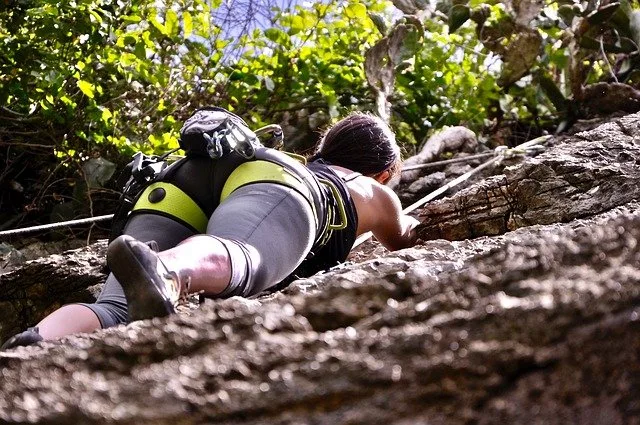Rock climbing is a sport that truly tests you in both strength and stamina. Both climbing and bouldering, the name for climbing on low rock formations without a rop, involves nearly every muscle in your body. And if you’re afraid of heights, it might be the best way to face your fear.
Any kind of exercise focuses on engaging your muscles. From your heart to your biceps, to your quads – these muscles need to be performed to work. When it comes to activating and training a diverse range of muscles. There are very few exercises that rival climbing.
Rock Climbing Is A Full Body Challenge
Expert researchers say that running, cycling, rowing, and most conventional gym workouts teach the body to perform consistent, repetitive motions. These motions are either to build strength, increase cardiovascular fitness, or both. However, climbing is a far more complex movement.![rock [longevity live]](https://longevitylive.com/wp-content/uploads/2018/09/action-adventure-challenge-449609-320x213.jpg)
Interestingly, rock climbing is a continuous series of different movements. There is no climbing surface or route that is the same, and you are always asking different muscles to perform during a climb. Every time you exercise whilst climbing, the muscle groups that are used change. This ensures you’re training a greater number of muscles. Research suggests this kind of dynamic muscle activation is much more challenging and fatiguing than simpler, repetitive movements.
There is a lot of pushing, pulling, and lifting involved in rock climbing. Many of these movements mirror aspects of resistance training. But climbing is an excellent cardiovascular workout too. A 2004 study looked at the physiology of rock climbing and saw that climbers use a significant portion of their aerobic capacity, and their heart rate response was higher than they’d predicted.
You’re Constantly Holding Your Own Weight
I went for a rock climb for the first time this past weekend. When you’re hanging onto a tiny rock, the muscles in your hips and torso strain to hold your lower half against the wall. You have to arch backward and extend one hand up to grip the next tiny rock. Your thighs start to shake, and your calves begin to burn whilst trying to hold on for dear life. No, I am only joking, but you do need to maintain good form and balance throughout if you want to last. A moment later, when the tips of your fingers have secured their grip, you have to quickly shift the focus on your muscles to others to remain safely secured on the climbing wall.![rock [longevity live]](https://longevitylive.com/wp-content/uploads/2018/09/climbing-1761386_640-320x213.jpg)
You will definitely feel your heart rate increase during a climb. However, it depends on how hard you push yourself. Whether you’re a beginner or pro, if the climb is challenging for you, your heart will get a workout. And just like any other heart-rate-raising exercise, rock climbing burns calories. Research says that even if a 155-pound person climbs with a moderate effort, it can burn between eight and ten calories per minute. According to research, this is almost equal to intense cardio workouts like spinning. Rock climbing is also quite a scary experience if you’re new to heights. So the fear of falling will rev up your heart rate and caloric expenditure like crazy.
You’ll Need Some Serious Brainpower
And the benefits do not stop there. The balance and neuromuscular coordination required for climbing calls for an enormous amount of brainpower. Studies have discovered that activities involving balance, muscle coordination, spatial orientation, and other aspects of climbing can significantly improve a person’s working memory, as well as other cognitive functions.![rock [longevity live]](https://longevitylive.com/wp-content/uploads/2018/09/accomplishment-action-adventure-461593-320x213.jpg)
Rock climbing requires a lot of dynamic, balance-dependent movements and therefore improves coordination and other motor skills. Researchers believe that climbing could improve the symptoms of those with neurologic conditions like multiple sclerosis and cerebral palsy. On top of feeling coordinated, you’ll feel a lot happier. Some studies show that eight weeks of bouldering might also reduce the severity of depression.
Think you’re not strong enough? Well, apparently anybody can learn to rock climb. Climbing walls, both natural and artificial, like those at an indoor rock climbing gym have different levels of difficulty. Experts say that with the right harnesses and gear, almost anyone can get started. However, you must be prepared to use a little strength!
I recommend consulting with your doctor first if you have a heart condition, especially if you’re afraid of heights. But, if you’re looking for a new way to build strength, coordination, and fitness. Plus you’d like to train other muscles in your body that hardly get worked, then adding a weekly climb to your routine is a great way to do it.



![women [longevity live]](https://longevitylive.com/wp-content/uploads/2020/01/photo-of-women-walking-down-the-street-1116984-100x100.jpg)









